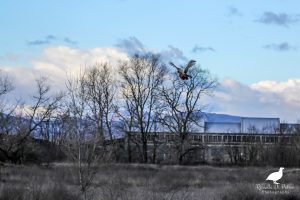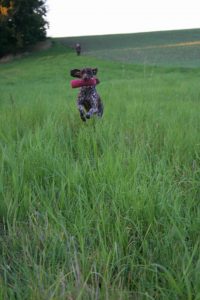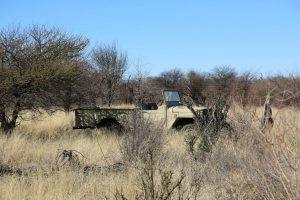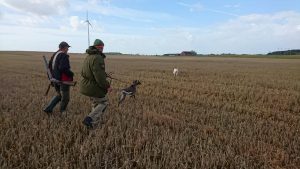Miracles happen at Sandrigham: Norfolk Trials
Almost three months later, I am finally here to write down what happened. On Sept 7th 2017, in fact, Briony won Novice Stake on Partridge at Sandrigham, organized by the Pointer Club of UK. Some might argue that, well, it’s “just” a Novice Stake, but for me it is a great achievement. Briony is not my first English Setter, I got the first one, “Socks” (Slai di Riccagioia), in 1999, but he was a rescue and he came to me after having be discarded by a “pro” trainer and with a bag full of behavioural problems. In his own way, he was a smart dog, we managed to go hunting alone together (he did not want men with shotguns around him), but there was no way I could rehab completely and train him for trials. I had not enough skills, nor experience, and he would not have dealt well with formal training sessions. He, however, opened me new doors as we started training for rough shooting and I got a firearms and hunting license. I met people, got new friends and spent many years rough shooting over English Setters and other pointing breeds up and down the hills of the Northern Apennines. I, somehow, had the chance to watch- and shoot over- hundreds of dogs during those years, and it was an incredible experience. I also began attending trials and to work for canine and shooting magazines which lead me to meet breeders, judges and handlers…
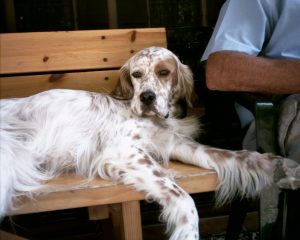
After his death, when I started looking for another setter, I had very clear ideas about what I wanted in my next dog, but not so clear ideas about where to find her! It took months, but I finally located my litter and my puppy, on a farm on the Swiss Alps, not too far from Sankt Moritz (posh dog!). I knew what I needed to know about Briony’s dad, but mum was quite a surprise: she was beautiful, gentle and smart. She came with us heeling off lead to the small village’s café and then sat quietly under the table. I loved that, as well the whole bloodline registered in the pedigree and the parents’ health clearances. When I brought Briony home, people thought she was cute, but too expensive, and that I was going to “ruin” her, training her in my own way and socializing her too much. I just thought she was a terrible pup who did not like me at all. It took quite a while to become friends, probably she was just testing me to be sure she was in good hands!
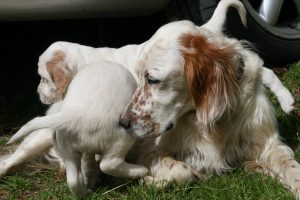
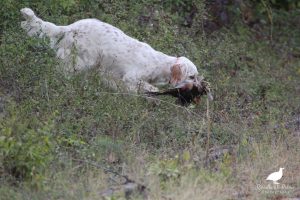
She was naughty, but smart, and she quickly developed in a good hunting companion. Sometimes she had a mind of her own and sometimes she was not the easiest dog to handle, but she surely did not lack of determination and bird sense. She was, and she still is, strong willed and sensitive at the same time. Thanks to friends, we had access to some private estates where she could meet much more birds that she could have met on more affordable – by me – public grounds. Other people introduced her to woodcock and, I still remember the day, with my surprise, she pointed her first snipe. During these hunting seasons, she learnt to work with other dogs and we worked a lot on backing and on remaining steady on point. I must admit I had good teachers, and that skilled hunters helped us to locate birds, but steadiness to wing was not required. Hunters here want the dogs to be steady on point, but after the bird flies, all they wish is to hit it, none cares anymore about the dog.
In the meantime, as she also grew prettier, I entered her at a dog show that took place nearby and, to my surprise, she was awarded a RCAC (RCC), so I decided to continue on this road. Briony, however, had other plans and after a stressful indoor show, she decided she wanted to end her career as a show dog. She had already a CAC in her pockets and I did not want her journey to end. I am not a show person, and I consider dog shows boring, but I wanted to prove that a good looking working dog, from working (mountain hunting and mountain trials) bloodlines, could make it. So, we went together to take handling lessons with Richard Hellman, a great handler and a great person. Briony seemed to enjoy the lessons and, in August 2015, she became a Show (full) Champion. I also think that having learnt to face the ring she somehow increased her self esteem.

Field trials were next on my list, but there was a HUGE problem: I did not want to send her away for training, nor to hire a professional trainer as people normally do here. I wanted to train and handle Briony by myself, easier said than done in Italy where field trials are dominated by male professional handlers. But, thanks to an unexpected series of coincidences, in the summer of 2015 I ended up watching the Champion Stake for Pointers and Setters in Northern England and… I had an awakening! I saw some “ordinary people” handling their dogs to a very high standard and I saw very obedient setters! I was used to see very obedient Drahthaars (GWPs), but the average Italian Setter is usually quite a wild critter! I could not believe setters could be that obedient and, as naïve as it might sound, I was impressed.
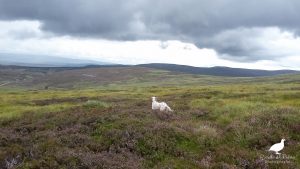
Briony herself was pretty wild at the time and her nickname was “Tigress” but, again, unexpectedly, a good mentor came to us. You can read more about Briony’s taming for field trials and about “White Feather” clicking here but, in a few words, I would describe her training a demanding task, it was equally rewarding though! It took a while to tame “Tigress”, but as soon as she decided to cooperate, she became impressively reliable and well behaved. This is how we ended up on the moor in the summer of 2016, and this is how my passion for British trials developed even further (you can read more here). Our first experience with grouse was not that bad: she always behaved and she kept improving but paid her inexperience with grouse during the English Trials and she paid my inexperience with trials in during the Scottish – and the English- trials. She still needed some fine tunings but, overall, I could not complain. At the end of the circuit, I went home with no awards but determined to save money and to go back in 2017.
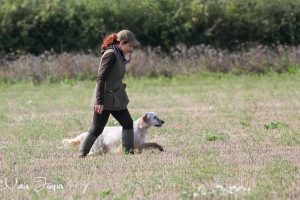
But, when the time to go again on the moors was close to come, I had to withdraw all my entries as Briony anticipated her season. I wasn’t happy, I was quite disappointed, no… honestly… I was quite upset, but there was not much else I could do. Some friends, however, tried to cheer me up advertising September trials on partridge. It is easier to get a run, they said, the atmosphere is very relaxed, they added and… we are going to run at Sandrigham Estate, on Queen Elizabeth II’s grounds, they concluded. I must admit the last thing they mentioned was very tempting: it was thanks to such a good advertisement that I decided to bet on partridge trials in Norfolk. That was a brave bet, I shall admit, as I was perfectly aware they were going to be more difficult than grouse trials. While gathering information, I learn that: 1) during the first round, usually on stubble, dogs were going to be evaluated mainly for pace, style and ground treatment and that 2) “a few” hares were going to be present. Uh, I was forgetting the sugar beet! So well, while I was going to do my best to show up with a well behaved dog, going there to win was not surely written down in my agenda. I just wanted to be there, see people, get to know things better, learn more and feel part of a world I like.
Briony started the circuit well (we went to the 2nd round in 4 trials out of 9) and, even if, we could not find any birds on our paths, she was behaving well and respecting hare nicely (I do not have hare here, just rabbits and cats to train on). I was happy, we were learning more and enjoying the social side of September trials : I do not drink, but I was always at the pub! It was nice to see friends doing well and, especially after IGL Snettisham trials , when no awards were given, I was super happy to see Rhia (Tapper) and Sara (Chichester) receiving the Gun’s Choice rosette. Trials proved to be as difficult as I expected: while there were plenty of hare, feathered wildlife was scarce or, should I say, very smart and very professional at hiding. On Thursday, 7th of September, (Pointer Club trial at Sandrigham) I was number 13 AND the bye dog (quite a scary combination), but she did well in the first round, and well again in the second, so I knew I was going to get “something”, but I did not know what.
When the secretary announced that I had won First Prize, I could not believe it and indeed, the Vaux Silver Tankard, fell from my hands a couple of times! It was like living in a Disney movie and this article should have explained you why. She is the first dog I have ever trained for trials, and I trained her all by myself. Yes, many wonderful people helped me through the journey (in Italy and in the UK, and I am grateful to them all), but I have always been the one in charge. I am just a normal person with limited training opportunities coupled with a high degree of stubbornness and self discipline which surely helped. This is why everything that could sound normal to someone else, is so special to me, and yes, winning an award at Sandrigham confirms that Briony is a posh dog!
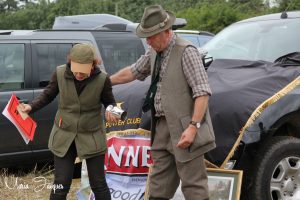
Ps. I promise I will also write on other dogs – and not just on mine – as there will be more articles on September trials, (all partridge trials rusults can be downloaded here) in the meantime, if you have a chance, take a look at the research project I am working on for my Veterinary Medicine dissertation.
Still curious about British trials? Check the section A Month on the Moor or click here.


